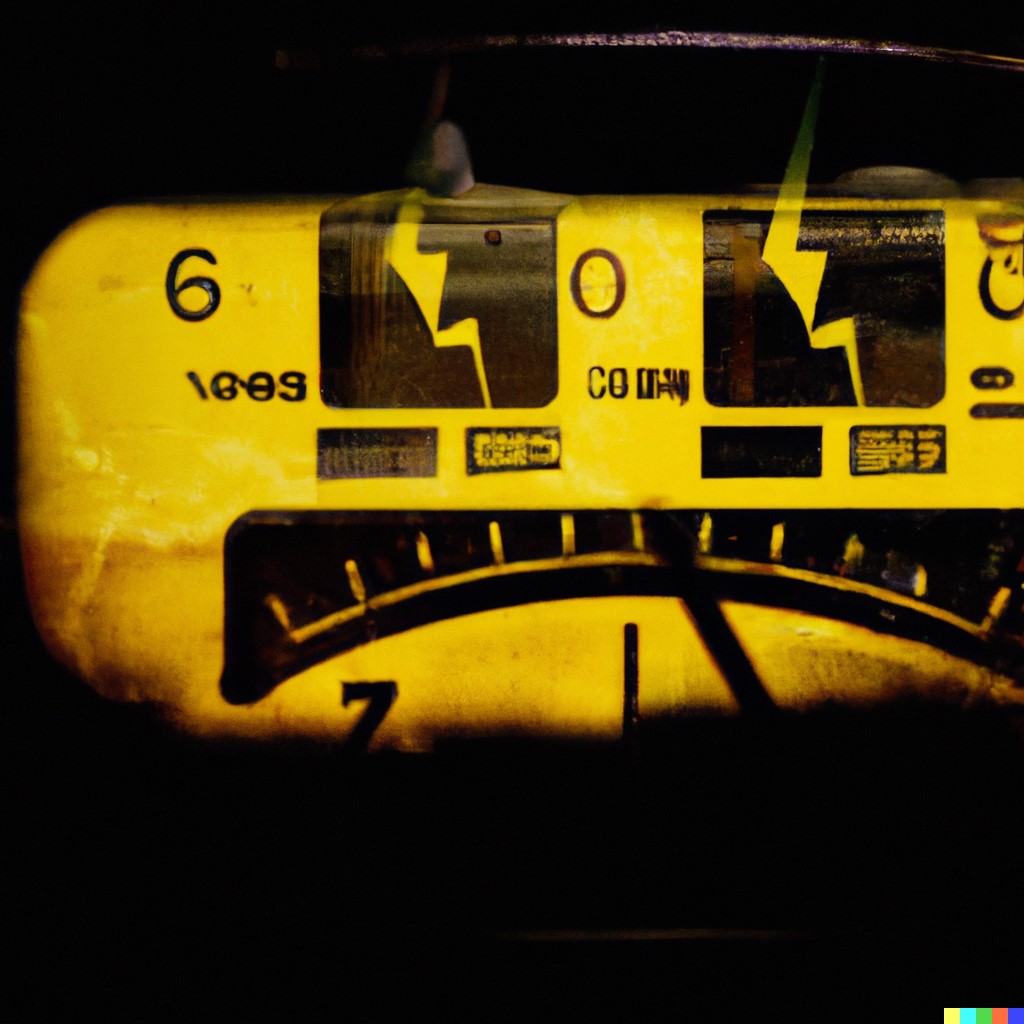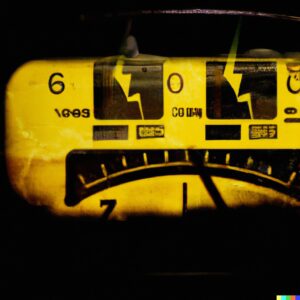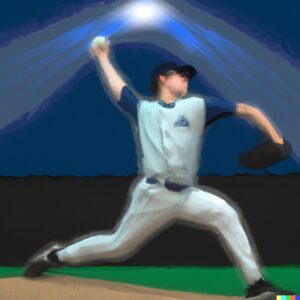The Monday Main Slates include the nine evening games on both DraftKings and FanDuel, fortunately foregoing the bane of season-long fantasy baseball: the Patriot’s Day game in Boston. The nine games on the MLB DFS slate this evening feature a strong list of starting pitching options and a few obvious names to target with bats. There are also a few interesting wrinkles to the slate overall today, with potentially under-owned options from the cheaper mid-range of pitchers affording the opportunity to roster unique bat combinations that are simply not accessible when rostering more expensive premium starters. The Power Index can help inform those selections, but as always is it not a direct guideline to the best stacks, as it is only indicative of the upside for power and not sequencing and run creation. Accounting for the whole is important in selecting teams for stacks if building a limited pool of entries.
Main Slate Power Index – 4/17/23 – DraftKings & FanDuel Main Slates
The power index represents a team’s opportunity for home run upside in the matchup against the scheduled starting pitcher. This is not a direct guideline for stacking, but it can be utilized to determine the most likely sources of power-based contact, hitters who are not homering are frequently hitting doubles and driving in runs, and providing valuable MLB DFS scoring. The “Full” column is the average of our home run opportunity score for each player in the lineup from 1-9, while the “Top 6” column averages only hitters 1-6, where teams typically place their biggest bats.
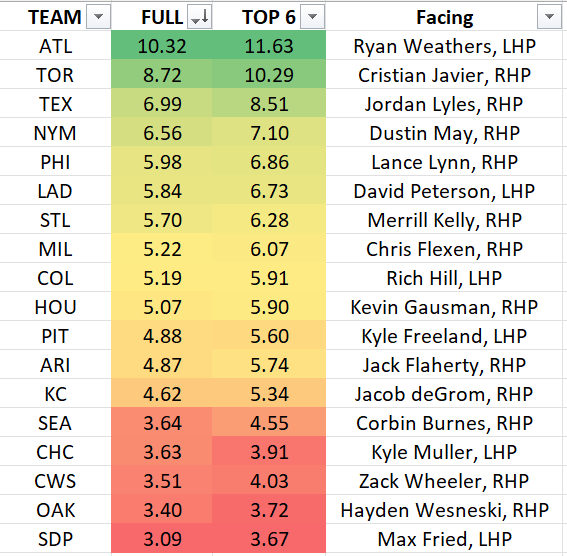
The Braves are once again at the top of the board, this is going to be a theme all season for the power-hitting Atlanta squad. The matchup against lefty Ryan Weathers has the right-handed bats in the projected lineup looking juicy, while lefty slugger Matt Olson should not be ignored for the same-handed matchup. Olson loses very little against fellow lefties and has always been able to hit them for power, he should be played as usual assuming he is in the lineup. In the interest of not repeating the same analysis too many times in too few days, the key Braves will be as usual: Ronald Acuna Jr., Olson, Austin Riley, and Sean Murphy, with all of Ozzie Albies, Vaughn Grissom, and Marcell Ozuna also looking playable. Ozuna leads that later group with a 10.83 in our home run model.
The San Diego Padres are in the bottom spot of the Power Index today, they look like a flat play against Braves starter Max Fried, who has been excellent at limiting premium contact and home runs throughout his career. Fried threw 185.1 innings in 30 starts last year and allowed just a 1.64% home run rate on the back of a fantastic 31.9% hard-hit rate allowed. The southpaw yielded just a four percent barrel rate with a 7.6-degree average launch angle and just 86.2 mph average exit velocity for the season. Fried was similarly good at limiting hard hits, barrels, launch angle, exit velocity, and home runs in his 165.2 innings over 28 starts in 2021. The starter is not a major standout for strikeouts, but he is a somewhat above-average option who had a 23.2% rate last year and a 23.7% mark the season before, and he limits opportunities as well as anyone in baseball. Fried had just a 4.4% walk rate and a 1.01 WHIP last year and a 6.1% walk rate with a 1.09 WHIP the season before. The lefty had a 3.09 xFIP and a 2.48 ERA last year and a 3.45 xFIP with a 3.04 ERA the year before, it is equally as difficult to sequence and create runs against Fried as it is to hit home runs against him. This has Padres bats looking potentially overpriced and like something of a difficult spot for MLB DFS purposes. They may come up low-owned for the matchup, but Padres may be better left to the field in this matchup. Xander Bogaerts, Manny Machado, and Juan Soto are the go-to Padres bats, they have a 3.43, 4.98, and 5.17 respectively in our home run model today. The numbers plummet from there, Nelson Cruz checks in with just a 3.44. Against a left-handed pitcher. Typically, Nelson Cruz against a lefty would leap over the 10 mark for an above-average chance at a home run, Fried saps power to this degree. Everyone else in the lineup is at a 3.0 or below for home run potential tonight.
The Blue Jays are in an interesting matchup against Cristian Javier, who is good at limiting premium contact and has not allowed a tremendous amount of power in his career. The team is profiling well for home run upside, which they typically will, but Javier is a polished high-end starter, which puts a dent in the overall stacking appeal. Toronto may be a better source of one-off power bats than it is a team to full stack in this matchup. Last season, Javier struck out 33.2% of opposing hitters while pitching to a 3.53 xFIP with a 2.54 ERA over 148.2 innings, allowing a 2.91% home run rate while limiting hard hits to just 33.3%. So far this year, the righty has just a 19.7% strikeout rate, with hard hits climbing slightly to a still-good 35.2% and barrels climbing from 7.2% to 9.3% in the tiny sample. Javier is a flyball pitcher who may give up a home run in this contest, but it is difficult to envision the Blue Jays hanging a gigantic number on him. Bats to consider for home run potential in the Toronto lineup include the obvious core of stars George Springer, Bo Bichette, and Vladimir Guerrero Jr. at the top of the lineup. They are carrying 11.33, 9.41, and 13.67 marks in the home run model. Bichette’s 9.41 is actually slightly lower than the 9.91 carried by lefty slugger Daulton Varsho and just edges out the 9.22 sported by Matt Chapman. The average remains high with lefty Brandon Belt in the sixth spot in the projected lineup. Belt could end up somewhat low-owned and he costs just $2,200 on both sites. The first baseman is slashing .152/.200/.242 in his part-time role in Toronto, but he is not far removed from the 2021 season in which he hit 29 home runs with a .323 ISO and a 158 WRC+ in only 381 plate appearances. Brandon Belt is a potentially sneaky home run play on this slate. The power diminishes in the bottom third of the lineup, but if Danny Jansen plays he is pulling in a respectable 7.55.
The Rangers are in a good spot for power, but they are missing the team’s best bat, with Corey Seager out for an extended stretch. Still, Texas’ projected lineup features loads of power and a good mix of hitters on both sides of the plate. The team’s sequencing and run-creation abilities are something of a question but with league-average righty Jordan Lyles on the mound that is less of a concern than if the team were facing stiffer pitching competition. Lyles had an 18.6% strikeout rate in 179 innings over 32 starts last year and a 19% rate over 180 innings in 30 starts the year before, he is the picture of consistency over quality. Lyles had a 4.40 xFIP with a 4.42 ERA and a 3.36% home run rate last year, allowing a significant 10.4% barrel rate. He was better for barrels allowed with just a 9.1% rate in 2021, but worse overall for power allowing a 41.6% hard-hit rate and a 4.94% home run rate while pitching to a 4.73 xFIP and a 5.15 ERA. Lyles is a targetable pitcher and the top of the Texas lineup profiles well for home run upside. Marcus Semien has two home runs on the season and is slashing .250/.279/.406 with a .156 ISO. With apologies to column favorite Brandon Lowe, Semien has been baseball’s best power-hitting second baseman for the past few seasons, with 27 home runs last year and 48 the year before. Josh Smith has not hit for much power in the Show to this point, his 4.59 is a blemish in the top of the lineup’s home run ratings for this matchup, Semien is at 10.42 above him and Nathaniel Lowe and Adolis Garcia are at 10.66 and 10.31 in the third and fourth spots in the projected lineup. Smith has no home runs and a .000 ISO over 37 plate appearances. He hit two home runs and had a .052 ISO in 253 plate appearances. There might be a fan attending this game who would be better suited to hitting second. Lowe and Garcia are prime targets for stacking or one-off shares, they have excellent skillsets for creating MLB DFS scoring. The lineup continues with home run potential, with Josh Jung hitting fifth and pulling in an 8.71 in our home run model. Jung is off to a strong start, slashing .291/.339/.455 with two home runs and a 121 WRC+. Switch-hitting catcher Jonah Heim has a 10.7% barrel rate and a 42.9% hard-hit rate over his first 43 plate appearances, hitting two home runs so far. Last season, Heim had 16 home runs in 450 opportunities, he is a sneaky catcher for $3,200/$3,000 if he is in the lineup. Robbie Grossman, Travis Jankowski, and Leody Taveras bring up the end of the projected lineup, Grossman has an average 5.01 in the home run model, with the other two slipping lower, but Taveras isn’t off the board at 4.98 when considering the addition of his speed at a $2,200/$2,500 cost to wrap-around to a top of the batting order stack that skips Smith for lack of Seager. A Taveras-Semien-Lowe-Garcia(-Jung/Heim on DraftKings) stack is a viable approach to differentiating Rangers bats while maintaining quality and correlation.
Follow Us on Twitter. Join us in Discord.

